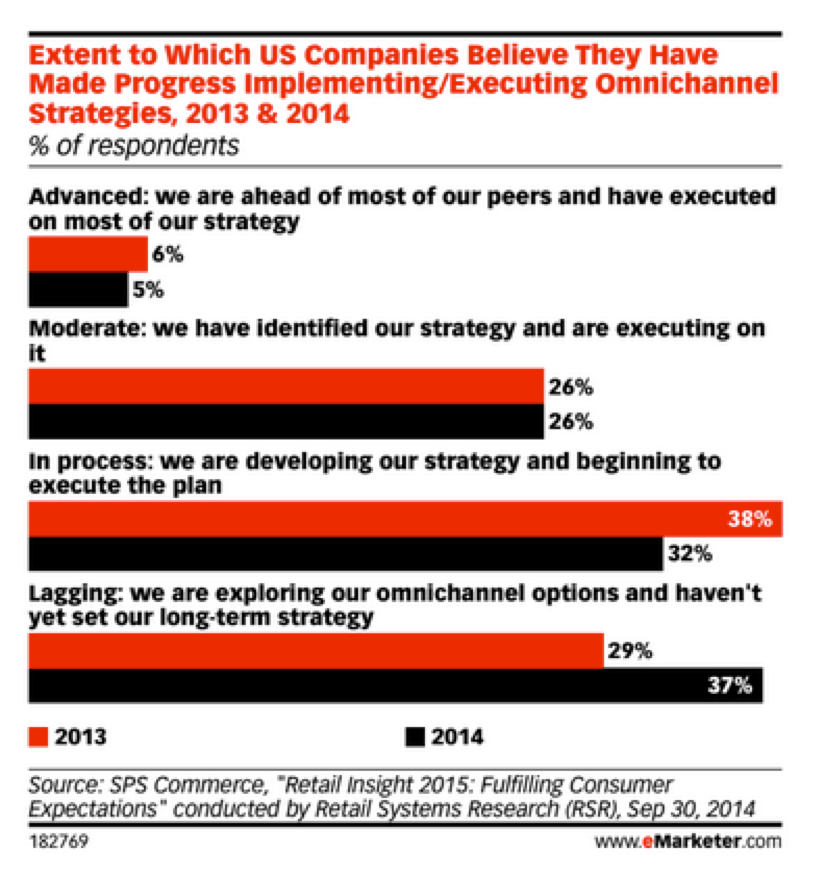Marketing
The 3 Biggest Barriers to Adopting Omnichannel
July 15, 2015

To keep up with today’s highly mobile, device-agnostic, omnivorous consumer, brands must adopt an omnichannel strategy: one that provides customers with a cohesive shopping experience and that also positions the brand for success at every touch point along the path to purchase.
Industry statistics imply that more marketers are committing to omnichannel – 37% of respondents to a recent eMarketer survey reporting that they are exploring their options for an omnichannel strategy – but the reality is that only a small fraction of firms are fully executing a strategy. In that same eMarketer study, 32% indicated that they were in just the early stages of implementation; as we all know, that road can sometimes be a long one!
There are three major barriers to implementation that create friction in deploying an omnichannel strategy: siloed organizational structures, outdated infrastructure and the absence of a roadmap dedicated to an omnichannel future. And with just 5% of those have successfully executing on omnichannel, these barriers have obviously proven quite material.
Barrier #1: Siloed Organizations
Customers don’t distinguish between channels, and their shopping paths regularly zig zag from online to in-store, from desktop to smartphone to tablet, and so on. For many brands, these channels may be managed by completely different teams and departments; in other words, rather than working together, online and offline sales departments often compete with each other for sales, or “Rob Peter to pay Paul.”
Breaking down barriers between sales channels inevitably unlocks significant value and brings significant efficiency gains to marketing budgets. (And not to mention, a cohesive approach to the channels – ideally manifested as a single customer view – will undoubtedly yield a strong customer experience, which pays dividends when it comes to customer retention.)
Many brands are implementing omnichannel strategies by pushing into new channels: Amazon, for example, has added physical locations where shoppers can pick up their own purchases, and also plans to open stores in New York and San Francisco. Warby Parker was web-first but has since expanded into brick-and-mortar. Regardless of the approach, it is imperative that the marketing team act as a united front in understanding data and optimizing accordingly.
Barrier #2 Outdated Infrastructure
Even once brands have committed to breaking down organizational silos, oftentimes their omnichannel strategy can still be hobbled by legacy infrastructure that doesn’t support a new way of thinking and working. With ideas flowing freely among teams, it’s imperative that data can flow freely as well.
The end goal here is to be able to consider all customer data points holistically. When we know that consumers often access several channels before making a purchase – 42% of them research a product online prior to making an in-store purchase, and 27% comparison shop on their smartphones while they’re in the store – it only makes sense that we would look at overall sales and the factors that drive them, and not to remain focused on tying sales to one specific channel. (And of course, attribution is everything.)
A unified platform with an agile database that can collect and analyze data in real time to help drive the optimal customer experience is integral to your omnichannel marketing strategy, and a single customer view sits at the crux of that. And more importantly, the “pull” force of this data is not enough; the “push” mechanism to customers must be consistent and cooperative across all of the pertinent channels – mobile, on-site, email, in-store, etc.
It’s not always necessary to start completely from scratch, but marketers should make a concerted effort to link legacy systems together to enable the 360-degree view that is so paramount to driving customer relevancy.
Barrier #3: No Omnichannel Roadmap
Customers are already functioning in an omnichannel world, so marketers must adopt a strategy that aligns with that behavior. There’s no one-size-fits-all omnichannel strategy, so you’ll need to start by answering some key questions: what are your overall goals? What teams can you bring together for this effort? Which systems should you prioritize for integration, retirement, upgrade?
Consider this: a Forrester Consulting study showed that 39% of customers are unlikely to visit a retailer’s store if they can’t find inventory information online, and 50% of them want the option to pick up purchases in the store. Is this information relevant to your own business? Understanding the drivers of customer satisfaction is paramount to defining strategy.
The perfect mix and balance of channels varies by business. Menswear retailer Bonobos keeps limited inventory in stores, and focuses its in-store staff on recommendations for online purchases. Bonobos CEO Andy Dunn told eMarketer that customers have responded overwhelmingly to the personal touch, and that the strategy has resulted in 75% more purchases by shoppers.
Rent the Runway, which provides designer dress and accessory rentals, has added brick and mortar locations to its popular online business, namely to provide customers with fitting rooms. Like Bonobos, Rent the Runway co-founder Jennifer Flies found that customers who visited a physical store tended to place higher value orders than online shoppers, according to eMarketer.
Marketers must focus on the analytics that uncover these gems – the drivers of engagement – and build their omnichannel approaches accordingly. Long story short, a winning omnichannel strategy starts with putting the customer first. Your brand is palpable to your customer at every touchpoint – regardless of the channel – so react to each of those opportunities with the utmost relevance in order to improve the overarching customer experience and ultimately, your own bottom line.
—Cassie Lancellotti-Young, EVP of Customer Success at Sailthru
The State of Brand Loyalty in the U.S. in 2023
Related




